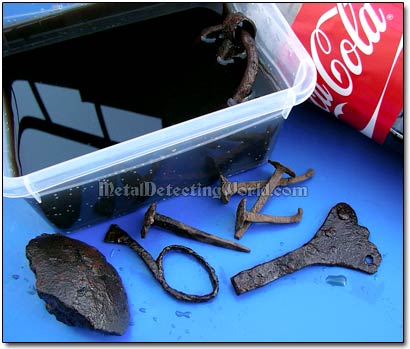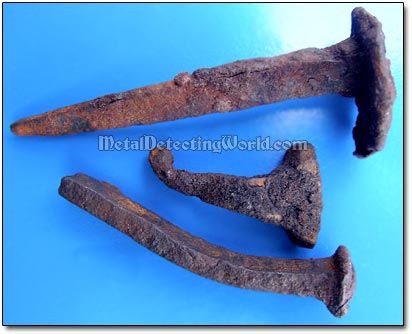Rust Removal with Electrolysis - A Detailed Illustrated Tutorial, page 4
1. Introduction: Advantages of Electrolysis Method Over Other Methods of De-Rusting
Rust Removal with Electrolysis is one of the most efficient and effective methods of cleaning iron artifacts. The homemade electrolysis devices are very cost-effective, safe and simple to set up, operate, and maintain.
The cleaning process is based on both the Ferric Oxide reduction process and mechanical cleaning action of the evolved Hydrogen gas.
The electrolytic de-rusting has many advantages over the traditional methods such as mechanical - grinding, sand blasting, heavy wire brushing, and chemical - acid bath treatments with hydrofluoric acid, vinegar (acetic acid), hydrochloric acid (muriatic acid), etc.
There are also Rust Converters which do not remove the rust products but convert them into a more stable material.
Mechanical methods require a manual skill and manual ability to use mechanical tools. And if you need to de-rust a valuable or artistic iron artifact, you cannot use any of mechanical methods because they can easily destroy the value of the object. To use chemical methods, one has to be educated and experienced in handling acids and other chemicals, nothing to say about many chemical safety rules that cannot be broken.
All acids not only dissolve rust but also promote it, so, after any acid treatment, you must cover an artifact with a protective coating (like an anti-rust paint) immediately. Certain acids can produce some harmful vapors. All acid treatments, excluding Phosphating (more info about it down below), either remove unrusted surfaces while removing the rust, or leave the iron relics with a "pickled" look or a characteristic color and texture.
The electrolytic method does NOT remove the "live" metal while turning the artifact's rusty surface to metallic iron. The rust is electrochemically and mechanically forced away from the artifact; the rust scale is loosened and can be easily removed, or simply drops off. Unrusted iron surface is not affected in any way. That is why the electrolysis is a standard cleaning technique in the artifact restoration business.
Soaking iron relics in Fish Oil or Coca-Cola would be the less harmful method, but keeping the smelly baths (Coca-Cola begins stinking badly after a few days!) indoors for a month (Coca-Cola), or worse - for a few months (Fish Oil), would not make anybody happy. Below, for comparison, I'm showing photographs of iron objects derusted by four methods: Fish Oil, Coca-Cola, and Vinegar baths, and Electrolysis.
1) Fish Oil somehow fights the rust and improves the artifact's appearance. The only drawback is that it takes a way too long - sometimes a few months, to achieve satisfying results. I did not treat the iron rusty nails this way, so only a picture of iron artefacts - two knife blades, a barrel lock and a jointed horse bit, is available at hand.
These Iron Relics Underwent 3-Month Treatment with Fish Oil

2) With the Coca-Cola treatment, the iron relics do not acquire a fully satisfying appearance, but the process goes quicker because Coca-Cola contains a minuscule amount of Phosphoric acid. Phosphoric acid chemically converts an outer layer of rust to Iron Phosphate which forms a protective (corrosion resistant) layer around iron metal; however, the rust MUST be present for this effect to take place.
Coca-Cola Method of Removing Rust from Iron Nails and Small Parts

Treating iron artifacts with Phosphoric Acid solution, and those products that contain a small amount of Phosphoric acid, such as "naval jelly", Prep and Etch, and the like, is called Phosphating. Phosphating is a basis for the Rust Conversion technique. If you use the Phosphoric acid SOLUTION, you should keep in mind that putting a little bit too much of acid can cause irreversible damage to the base metal.
During the Coca-Cola treatment, you have to take the relics out of bath and check their condition a few times. Sometimes it takes a whole month to get rid of all surface rust. And even after that is done, the area might still show some rust. Below is a picture of iron square nails that still show both the rust and rust scale for having not been in the Coke bath long enough.
These Iron Square Nails Were in Coca-Cola Bath for Two Weeks
